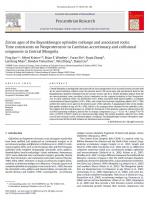Добрый день, Коллеги. Важное сообщение, просьба принять участие. Музей Ферсмана ищет помощь для реставрационных работ в помещении. Подробности по ссылке
Zircon ages of the Bayankhongor ophiolite mélange and associated rocks: Time constraints on Neoproterozoic to Cambrian accretionary and collisional orogenesis in Central Mongolia
Central Mongolia is geologically characterized by close juxtaposition of an accreted oceanic terrane with an arc-microcontinent collision zone. We present new U–Pb zircon ages and geochemical data for the Bayankhongor ophiolite mélange from the oceanic terrane and for a syenite porphyry pluton from the arc-microcontinent zone, providing critical constraints on the regional evolution in late Neoproterozoic to early Cambrian times. An anorthosite (655±4 Ma) associated with layered gabbro, a rodingite (metasomatized layered gabbro) (647±6 Ma), and a high-level isotropic amphibole gabbro (647±7 Ma) yielded the oldest zircon ages for the plutonic part of the ophiolite. A plagiogranite dike in the amphibole gabbro yielded an age of 636±6 Ma, which is the youngest date obtained for the ophiolitic rocks. We suggest that the long duration (ca. 20 Ma) for formation of this plutonic sequence characterizes the sea-floor spreading evolution, and the Nd–Sr isotopic composition (εNd(t) = +7.6 to +4.7; initial 87Sr/86Sr ratio = 0.70279–0.70327) points to a mid-ocean-ridge origin. The syenite porphyry, dated at 523±2 Ma, records the terminal or post-collisional phase of orogeny. The Bayankhongor oceanic lithosphere experienced at least 92Ma of drift between its formation and accretion.
Ophiolites are fragments of oceanic crust and upper mantle that have been uplifted and emplaced on continental margins or in accretionary wedges and island arcs (Robinson et al., 2008). In collisional orogenic belts such as the European Alps and the Himalayas ophiolites with complete stratigraphy (ultramafic rocks, gabbros, sheeted dykes, basalts and pelagic–clastic sediments; Anonymous, 1972) were obducted onto continental margins, generally shortly after their formation, and commonly mark plate sutures (Nicolas,
1989; Dilek, 2003). However, in many accretionary orogens dominated by accretionary wedges as in Mesozoic–Cenozoic Japan such complete ophiolite stratigraphy is rare (Isozaki et al., 1990), because the ultramafic rocks, gabbros and sheeted dykes are typically subducted (Kimura and Ludden, 1995). Consequently , accretionary wedges contain abundant fragments of basalt and pelagic–clastic sediments (Maruyama, 1997).
The Central Asian Orogenic Belt (CAOB) is a typical, wide (ca. 800km between the Siberian and the North China cratons), longevolving accretionary orogen (Sengör et al., 1993; Sengör and Natal’in, 1996, 2004; Kovalenko et al., 2004; Jahn et al., 2000) that comprises numerous island arcs, accretionary wedges, ophiolites and microcontinents (Badarch et al., 2002; Kröner et al., 2007; Windley et al., 2007). Amajor difference between the CAOB and the Mesozoic–Cenozoic of Japan is that the CAOB includes abundant, significant, distinctive ophiolite belts, as documented in northwestern China (e.g. Coleman, 1989), Mongolia (e.g. Badarch et al., 2002) and southern Siberia (Khain et al., 2002). The Mongolian ophiolites are Neoproterozoic to Palaeozoic in age (Khain et al., 2003; Tomurtogoo et al., 2006; Rippington et al., 2008), and some display a nearly complete stratigraphy. They occur in island arcs (e.g., Kuzmichev et al., 2005), accretionary wedges (e.g. Osozawa et al., 2008) and on terrane boundaries (Khain et al., 2003; Rippington
et al., 2008) and thus provide a link between oceanic evolution and continental growth. Despite their tectonic importance, the paucity of geochemical data and precise zircon ages has led to much debate about their origin, evolution, mechanism of emplacement and regional significance.
In this paper we focus on the Bayankhongor ophiolite mélange (ca. 300km long, up to 20km wide; Fig. 1A) in central Mongolia which is the largest and one of the best-preserved Precambrian ophiolite complexes in the CAOB (Jahn et al., 2004). The ophiolite mélange (Buchan et al., 2001, 2002; Buchan, 2002; Tomurtogoo et al., 2006; Osozawa et al., 2008) is tectonically wedged against and within 2 km-thick, accretionary complexes, namely the Delb Khairkhan mélange in the south, and the Haluut Bulag mélange
in the north (Fig. 1B). These relationships are comparable to those of Cordilleran-type ophiolites (Moores, 1982; Wakabayashi and Dilek, 2003; Spaggiari et al., 2004) that are the products of subduction-accretion. Additional lithotectonic units in central Mongolia are from north to south: the late Neoproterozoic South Volcanic Belt (island arc), high-K calc-alkaline granites and an early Paleozoic syenite porphyry and, the Burd Gol mélange (late Neoproterozoic–early Cambrian Barrovian-type metamorphic belt), and the Archean to Mesoproterozoic Baidrag microcontinent (Fig. 1B). We first review these units to provide a regional framework which is characterized by close juxtaposition of an arcmicrocontinent collision zone with an accreted oceanic terrane.
In order to place critical constraints on the early development of the CAOB, we report new U–Pb zircon ages and geochemical data for the Bayankhongor ophiolite (655–636 Ma) from the accreted oceanic terrane and for the early Paleozoic syenite porphyry (ca. 523 Ma) from the arc-microcontinent collision zone. The results enable us to propose a novel interpretation of the tectonic history for central Mongolia in late Neoproterozoic to early Cambrian times. We argue that accretion of a non-subductable, ophiolite- eamount/oceanic plateau terrane onto a convergent continental margin during the late stage of orogeny contributed to significant continental growth. In addition, we distinguish
Permo–Triassic diabase dikes (including Triassic dikes previously interpreted as ophiolitic “sheeted dikes”) and gabbros from the late Neoproterozoic Bayankhongor ophiolite. This, together with the geochemical distinction between ophiolite and post-sea floor spreading, off-ridge alkaline lavas, clearly points to a diversity of igneous formations for rocks in the Bayankhongor ophiolite mélange.




